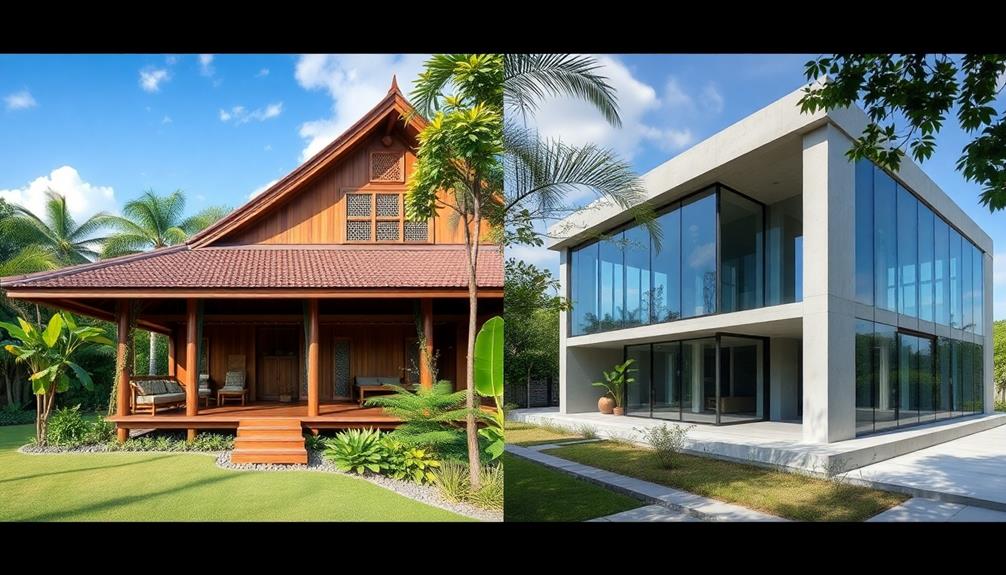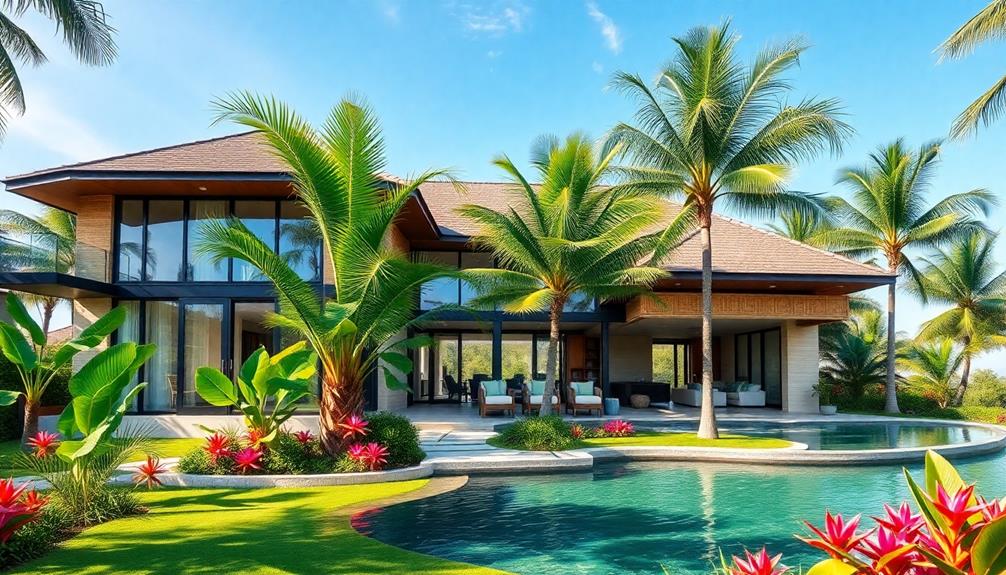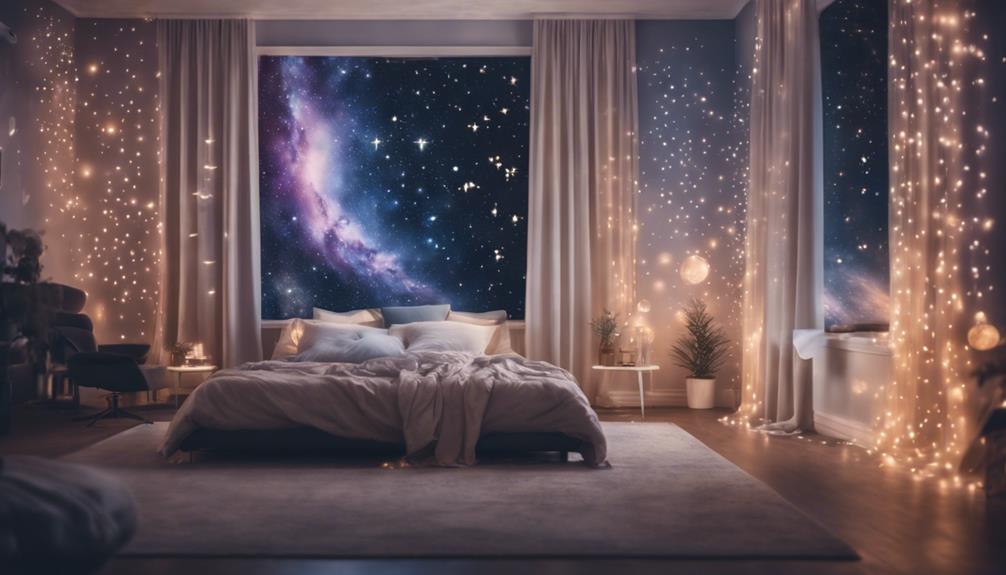When you compare thermal comfort in traditional Indonesian architecture and modern styles, you'll see distinct differences. Traditional designs use lightweight materials and incorporate passive cooling methods, ensuring better ventilation and lower indoor temperatures. They maintain a comfortable climate with ideal humidity levels. In contrast, modern architecture often relies on heavyweight materials, which can lead to poor air quality and higher energy consumption for cooling. This reliance makes it harder to manage indoor climates effectively during peak heat hours. If you're curious about how these elements affect overall comfort, there's plenty more to explore on this topic.
Key Takeaways
- Traditional Indonesian architecture maintains indoor temperatures around 29°C with 60% humidity, enhancing overall thermal comfort through passive cooling techniques.
- Modern architecture's reliance on heavyweight materials results in poor thermal performance and higher indoor temperatures compared to traditional designs.
- Extensive ventilation openings and solar shading in traditional homes promote natural airflow, while modern designs often lack these features, leading to discomfort.
- Traditional homes utilize lightweight materials that facilitate rapid cooling and effective cross-ventilation, unlike modern structures that struggle with indoor climate management.
- Energy consumption in modern architecture is higher due to mechanical cooling systems, whereas traditional designs achieve comfort with minimal energy use.
Characteristics of Traditional Architecture
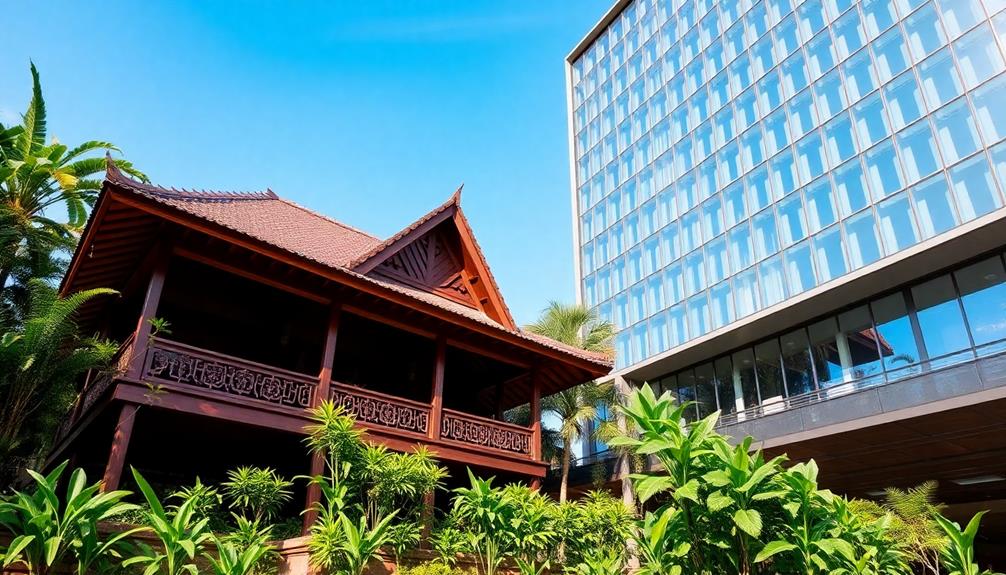
When you step into a traditional Indonesian house, you immediately notice how its design embraces the tropical climate. These structures are crafted with lightweight building materials, allowing for rapid cooling and effective ventilation.
Traditional Indonesian homes, such as the Rumah Adat, exhibit distinct architectural styles that vary by region, showcasing local craftsmanship while maintaining functionality. You'll find that traditional architecture features low thermal mass and extensive solar shading, which greatly enhances indoor air quality and thermal comfort.
Traditional Indonesian houses, particularly the Minahasa style, incorporate numerous ventilation openings that help maintain a comfortable atmosphere, especially during hot mornings. The architectural forms may include both stilted and non-stilted designs, primarily constructed from timber and topped with materials such as zinc or aluminum.
Passive cooling techniques are pivotal in these homes. Elements like verandahs, balconies, and thick walls work together to keep indoor temperatures pleasant.
Studies have shown that these traditional houses maintain lower mean indoor air temperatures compared to modern constructions, achieving greater thermal performance.
Characteristics of Modern Architecture
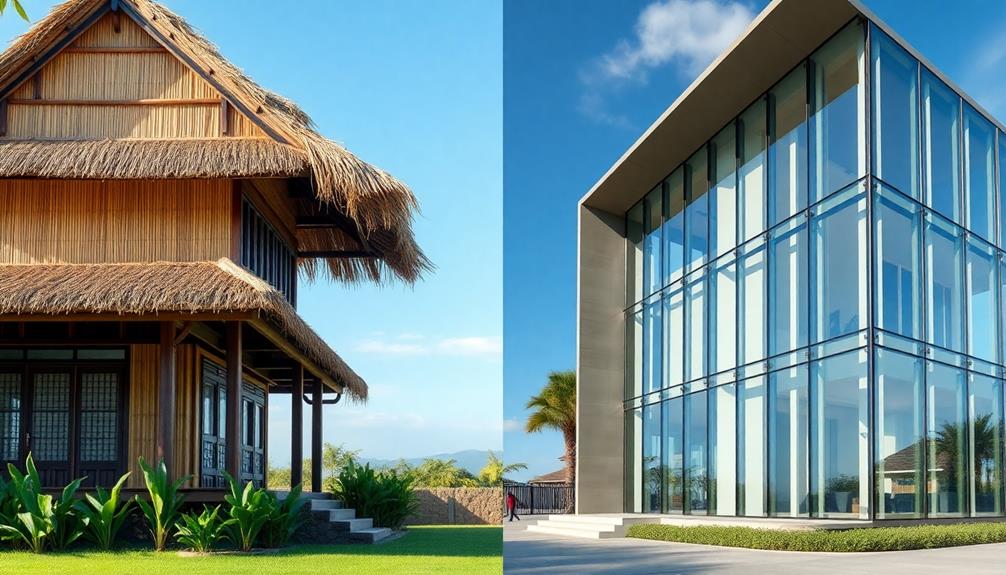
When you look at modern architecture in Indonesia, you'll notice it often relies on heavyweight materials, which can stifle natural ventilation.
This choice leads to design limitations that struggle with thermal comfort, especially during peak heat hours.
The emphasis on modern tropical aesthetics often blends indoor and outdoor environments, yet the reliance on such materials can hinder this natural harmony.
Plus, the increased dependence on mechanical cooling systems raises energy consumption concerns that are hard to ignore.
Material Usage and Impact
Modern architecture in Indonesia often relies on heavyweight materials like concrete and brick, which greatly impact thermal comfort. These heavyweight constructions tend to have high thermal mass, absorbing and retaining heat, which can lead to uncomfortably high indoor temperatures during the day.
Unlike traditional architecture, which utilizes lightweight materials like timber to promote rapid cooling and better airflow, modern buildings frequently struggle with natural ventilation. Incorporating elements like Indonesian decorative pillows can enhance comfort while reflecting cultural aesthetics, further bridging the gap between traditional and modern design.
In many cases, modern designs lack the extensive solar shading and ventilation openings found in traditional structures, further diminishing their ability to manage indoor climates effectively. This deficiency often leads to a greater dependence on mechanical cooling systems, which not only contributes to discomfort but also increases energy consumption.
To address these issues, it's essential to integrate climate-responsive design principles and low-cost materials inspired by traditional architecture. By focusing on lightweight materials and enhancing natural ventilation, modern architecture can greatly improve thermal comfort while reducing energy consumption.
Ultimately, understanding the material usage and its impact can help create more sustainable and comfortable living spaces in Indonesia.
Design Limitations and Challenges
Designing contemporary homes in Indonesia presents significant limitations and challenges that directly impact thermal comfort. Modern style housing often utilizes heavyweight construction materials, which lead to low levels of natural ventilation and create thermally unsatisfactory indoor environments.
Unlike traditional architecture, which effectively employs passive cooling techniques like thick walls and extensive shading, modern designs frequently ignore these vital elements, leaving homes uncomfortable during peak heat hours. Incorporating materials such as natural materials like wood and bamboo can greatly enhance thermal performance while maintaining aesthetic appeal.
Studies reveal that from 10:00 AM to 05:00 PM, modern homes experience significant temperature increases compared to their traditional counterparts. This discrepancy not only diminishes overall comfort but also elevates energy consumption due to the reliance on mechanical cooling systems. Such systems contribute to declining indoor air quality, as inadequate ventilation strategies fail to maintain healthy environments.
Moreover, there's often a gap between theoretical simulations and real-life observations in modern housing, highlighting important design limitations. To improve thermal performance and enhance indoor air quality, it's essential to integrate principles from traditional architecture into modern designs, ensuring that homes can better withstand the challenges of tropical climates while promoting sustainable living.
Energy Consumption Concerns
Energy efficiency is a pressing concern in contemporary architecture, particularly in tropical climates like Indonesia. Modern architecture often relies on heavyweight construction materials that limit natural ventilation, leading to thermally unsatisfactory indoor environments.
This contrasts sharply with Balinese interior design principles, which emphasize indoor-outdoor living and natural ventilation to promote comfort and reduce energy use. As a result, you might find yourself cranking up the air conditioning to combat the rising temperatures and humidity, greatly increasing energy consumption.
Unlike traditional houses that maintain comfortable indoor conditions at temperatures up to 29°C with around 60% humidity, many modern homes fail to achieve similar thermal comfort without excessive energy use. This issue arises from design choices that overlook passive cooling strategies, which can effectively minimize reliance on mechanical cooling systems.
Consequently, you could face higher electricity bills and contribute to a greater environmental impact. Studies show that during peak hours, indoor temperatures in modern houses can soar, pushing energy demand even higher.
It's clear that the shift toward modern architecture has often neglected the sustainable practices and natural ventilation techniques that traditional Indonesian houses excelled at. Focusing on energy efficiency and integrating these strategies can help create more sustainable and comfortable living spaces.
Definitions of Thermal Comfort
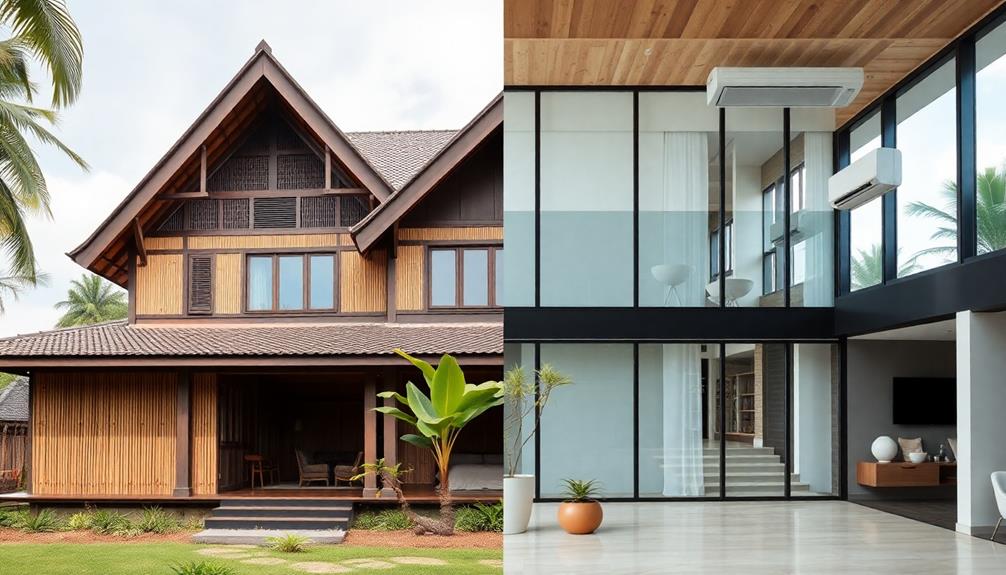
Thermal comfort's essence lies in how satisfied individuals feel within their thermal environment, typically thriving in temperatures ranging from 25.4°C to 28.6°C under ideal conditions. Key factors influencing your thermal comfort include air temperature and humidity, along with clothing thermal resistance and your activity level.
You might find comfortable indoor air temperatures at up to 29°C with 60% humidity, which can greatly affect your overall comfort levels. In Indonesia, the unique architectural styles, such as traditional housing designs, are often crafted to enhance ventilation and promote natural cooling, contributing to thermal comfort.
In Indonesia, the DISC scale is a valuable tool for evaluating thermal comfort, helping gauge your thermal sensation in various environments. Traditional Indonesian houses are designed to maintain lower mean indoor air temperatures, particularly during morning hours, which enhances your comfort levels.
In contrast, modern houses often struggle to provide adequate thermal satisfaction. Discrepancies between theoretical simulations and real-life observations highlight the challenges modern designs face in achieving ideal thermal conditions.
These insights into thermal comfort reveal how vital architectural design is in creating pleasant living environments. Understanding these factors allows you to appreciate the differences between traditional and modern architectural styles and their impact on your thermal experience.
Methodology and Case Studies
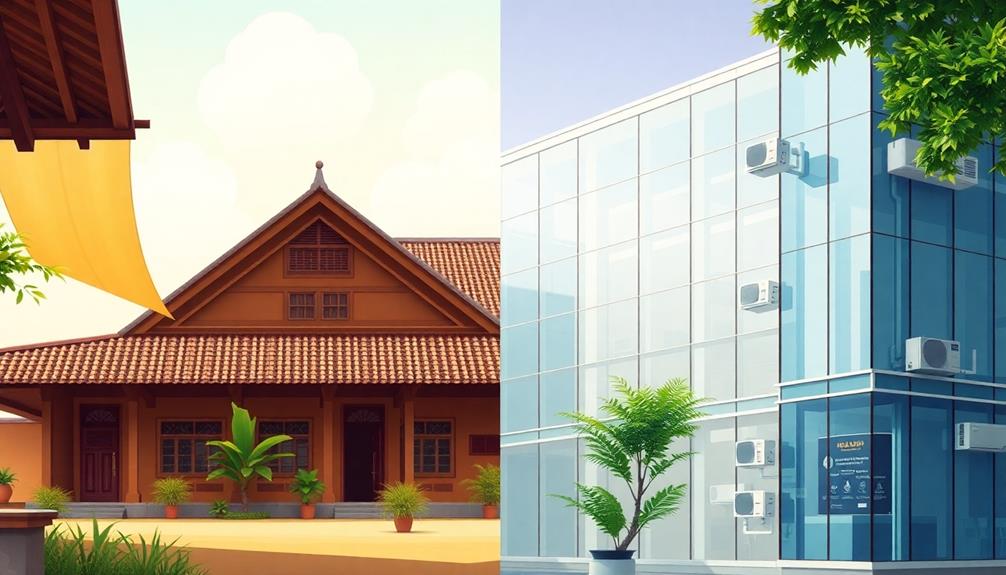
To understand the differences in thermal comfort between traditional and modern Indonesian architecture, a structured approach was taken in this study. The research involved a comparative analysis of 10 traditional houses and 10 modern style houses in North Sulawesi, with 60 adults providing thermal sensation evaluations through questionnaires.
You'll appreciate that field observations and measurements were conducted during hot seasons using digital thermohygrometers and anemometers to assess indoor thermal environment parameters, including temperature, humidity, and airflow. This study also draws parallels with the appreciation for traditional craftsmanship seen in items like the Indonesian Decor Mask, which reflects the rich cultural heritage and artistic expression inherent in the region.
The methodology also included a literature review sourced from 16 articles, focusing on architectural elements that influence thermal comfort across various Indonesian regions. Empirical studies zeroed in on specific traditional houses like Bantayo Poboide and Tambi, measuring their thermal performance under different climatic conditions.
These findings highlighted the effectiveness of passive cooling strategies inherent in traditional architecture, which often excels in providing better natural ventilation than modern style houses. Consequently, modern designs frequently struggle to maintain ideal thermal comfort levels due to their lack of consideration for these essential features.
Passive Cooling Techniques
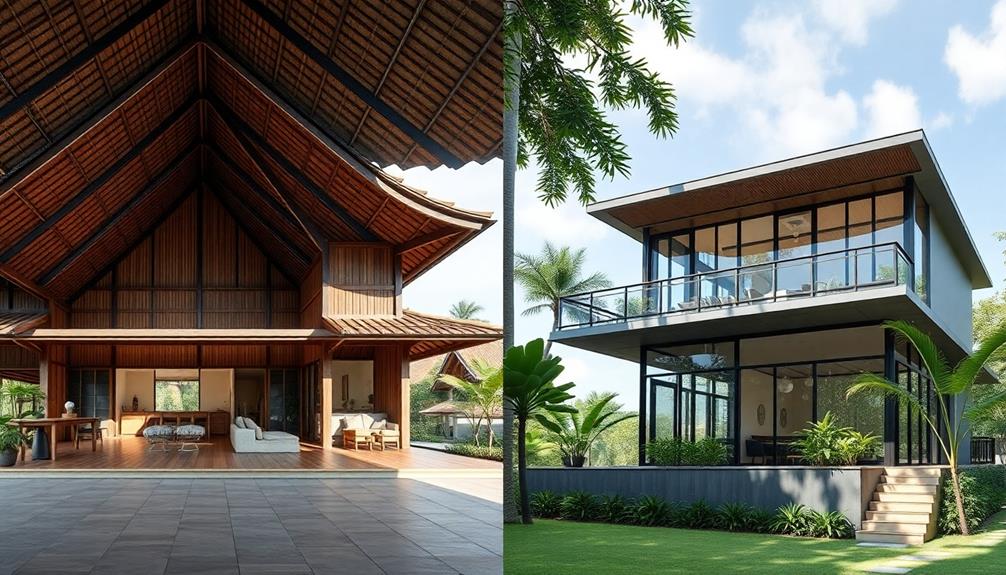
Traditional Indonesian architecture's brilliance lies in its effective use of passive cooling techniques, which are essential for maintaining comfort in warm, humid climates. You'll notice that traditional homes often incorporate thick walls and high ceilings, providing thermal mass that reduces heat gain during the day. This clever design strategy keeps indoor air temperatures comfortably below 29°C.
Additionally, tropical villa plans emphasize open spaces and large windows, further enhancing natural ventilation and light throughout the home.
Moreover, extensive verandahs and balconies enhance airflow, allowing natural ventilation to flow freely throughout the space. By strategically placing openings and utilizing cross-ventilation, these homes promote air exchange that greatly contributes to overall thermal comfort.
Lightweight materials and stilted construction further enhance airflow and minimize heat accumulation from the ground.
In contrast to modern constructions, which typically rely on mechanical cooling systems, traditional Indonesian architecture manages to maintain lower mean indoor air temperatures. This not only leads to a more comfortable living environment but also results in reduced energy consumption.
Natural Ventilation Strategies
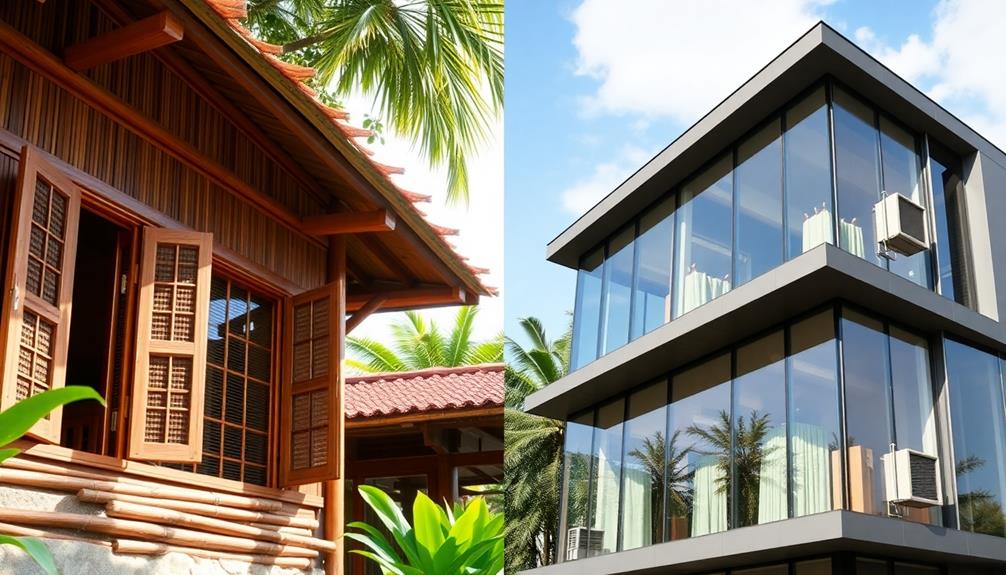
When you consider natural ventilation strategies, you'll notice how traditional Indonesian architecture excels in creating comfortable living spaces.
The incorporation of cultural artifacts, such as traditional artistry, further enhances the aesthetic appeal and functionality of these homes.
By optimizing building orientation and employing passive cooling techniques, these homes harness the natural flow of air effectively.
This approach not only enhances thermal comfort but also contrasts sharply with modern designs that often overlook these essential elements.
Passive Cooling Techniques
Natural ventilation strategies play an indispensable role in achieving thermal comfort in various architectural styles, particularly in traditional Indonesian homes. These homes utilize passive cooling techniques like cross-ventilation, which is enhanced by carefully placed windows and openings. This optimization of airflow considerably reduces indoor temperatures, creating a more pleasant indoor environment.
Additionally, incorporating elements such as traditional batik patterns can enhance the aesthetic appeal while promoting airflow through design.
The lightweight materials and thin, porous walls of traditional architecture facilitate better air exchange, vital for coping with hot and humid climates. Furthermore, features such as verandas and large roof overhangs provide shade, minimizing heat gain and fostering cooler outdoor spaces. This design approach contributes to improved thermal comfort indoors as well.
In contrast, modern housing often overlooks these effective passive cooling strategies, leading to a heavier reliance on mechanical cooling systems. This neglect results in less effective natural ventilation, ultimately affecting the indoor climate.
Computational Fluid Dynamics (CFD) simulations highlight that wind-driven natural ventilation strategies in traditional homes maintain lower indoor temperatures compared to modern constructions. By embracing these principles of traditional architecture, you can enhance your living environment's comfort while reducing energy consumption and promoting sustainability.
Building Orientation Effects
Building orientation greatly impacts the effectiveness of natural ventilation strategies in Indonesian architecture. In traditional designs, buildings are typically aligned east-west, optimizing airflow and capitalizing on prevailing wind patterns. This orientation enhances natural ventilation, which is essential for maintaining thermal comfort.
By utilizing features like verandas and large roof overhangs, traditional architecture facilitates cross-ventilation, reducing heat gain from direct sunlight.
Research shows that traditional homes maintain better indoor conditions, stabilizing temperatures around 29°C with 60% humidity, compared to modern houses that often exceed comfortable temperature thresholds. The thoughtful layout of these buildings maximizes the flow of cool breezes, notably improving indoor air quality and minimizing the need for mechanical cooling systems.
Additionally, strategically placed windows and openings in traditional architecture allow for effective air exchange, which is critical for minimizing thermal build-up throughout the day.
Environmental Implications for Design
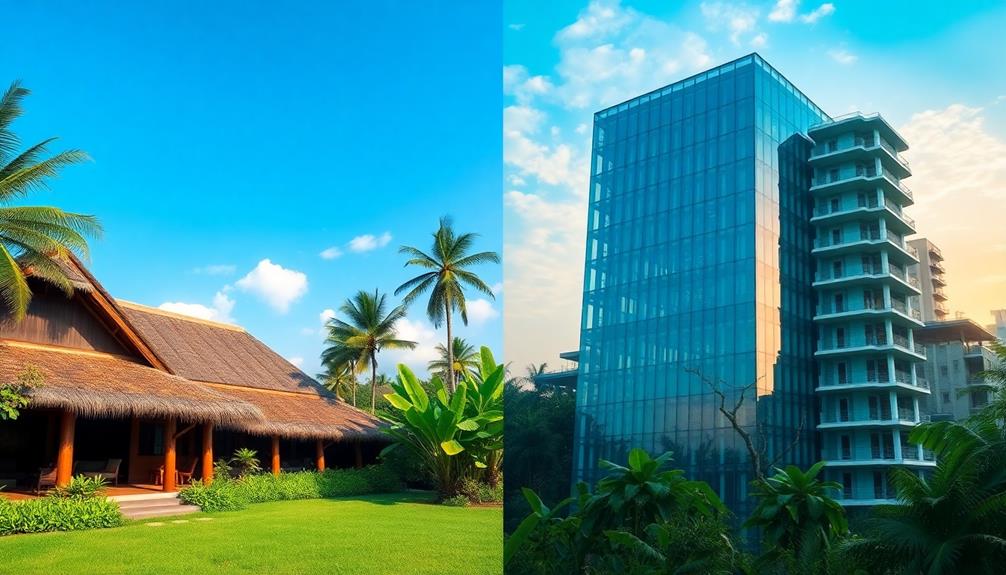
A significant shift in architectural design can lead to profound environmental benefits, especially when integrating traditional Indonesian principles. By adopting elements of traditional architecture, you can enhance thermal comfort while minimizing energy consumption in modern designs. Traditional homes utilize passive cooling and natural ventilation to maintain comfortable indoor temperatures, often below 29°C, compared to higher temperatures in modern structures.
| Design Element | Traditional Architecture | Modern Design |
|---|---|---|
| Cooling Method | Passive cooling | Mechanical systems |
| Ventilation Strategy | Extensive openings | Limited ventilation |
| Humidity Management | 60% indoor humidity | Often exceeds 60% |
| Energy Consumption | Low | High |
| Sustainability | Bioclimatic design | Less sustainable |
Emphasizing bioclimatic design in your housing approach can effectively manage humidity levels and enhance ventilation. By incorporating lightweight materials and strategic building orientation, you can reduce reliance on air conditioning, leading to a more sustainable housing environment. The integration of traditional elements not only improves comfort but also supports environmental goals, making it a win-win for modern architecture.
Challenges in Modern Housing
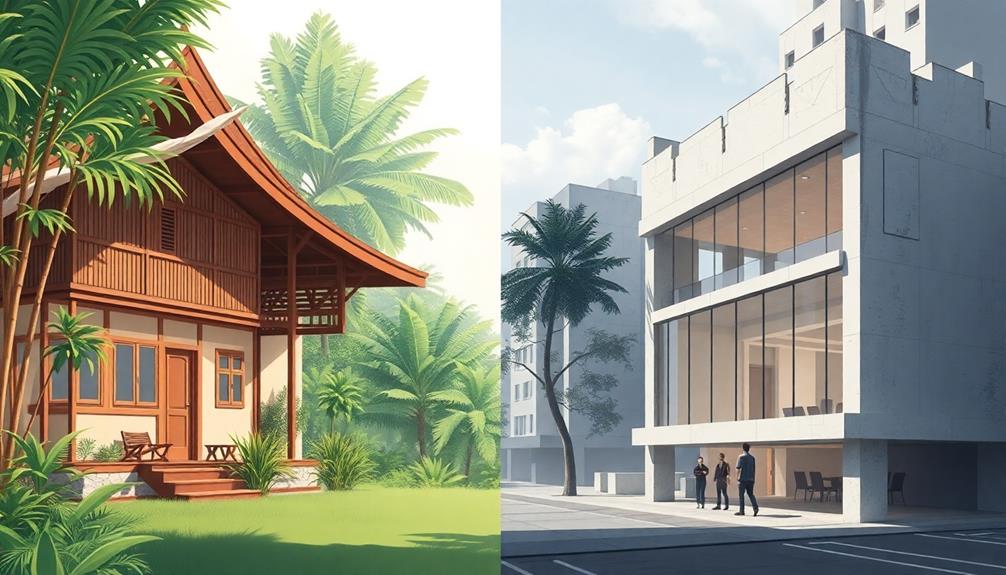
While modern housing offers contemporary aesthetics, it often falls short in thermal comfort and energy efficiency due to its neglect of traditional passive cooling methods. You might find that modern homes, with their heavyweight construction materials, trap heat and limit natural ventilation, leading to uncomfortable indoor environments.
Consider these challenges:
- Increased Energy Consumption: Many modern houses rely heavily on air conditioning, driving up energy costs and harming the environment.
- Subpar Indoor Air Quality: The lack of effective ventilation strategies can lead to poor air quality, especially highlighted during the COVID-19 pandemic.
- Poor Thermal Performance: Studies show that modern houses can be considerably warmer between 10:00 AM and 05:00 PM, often failing to maintain the comfortable indoor temperatures of traditional architecture.
In contrast, traditional Indonesian houses manage to maintain a comfortable indoor temperature of up to 29°C with 60% humidity.
Frequently Asked Questions
What Is the Thermal Comfort Standard in Indonesia?
In Indonesia, you'll find the thermal comfort standard identifies ideal indoor air temperatures between 25.4°C and 28.6°C. Comfortable conditions are maintained at temperatures up to 29°C, with humidity ideally around 60%.
What Is Thermal Comfort in Architecture?
Thermal comfort in architecture means you're satisfied with your indoor environment's temperature and humidity. It typically ranges from 25.4°C to 28.6°C, where good design promotes natural ventilation, enhancing your overall experience in the space.
What Are the Occupant Related Factors That Influence Thermal Comfort?
Imagine living in a cozy cabin with friends. Your activity levels, clothing choice, humidity preferences, and personal comfort zones all shape how you feel. Each factor uniquely influences your thermal comfort in any space.
What Equipment Is Used for Thermal Comfort?
To assess thermal comfort, you'd use digital thermohygrometers for temperature and humidity, anemometers for air velocity, and conduct surveys to gather feedback on comfort levels. These tools help you analyze indoor environmental conditions effectively.
Conclusion
In comparing traditional Indonesian architecture with modern styles, you'll see that the former often achieves better thermal comfort through passive techniques. For instance, studies reveal that buildings using natural ventilation can reduce indoor temperatures by up to 5°C compared to those relying solely on air conditioning. This not only enhances comfort but also lowers energy consumption. Embracing these time-tested strategies could lead to more sustainable and pleasant living environments in today's architectural designs.
